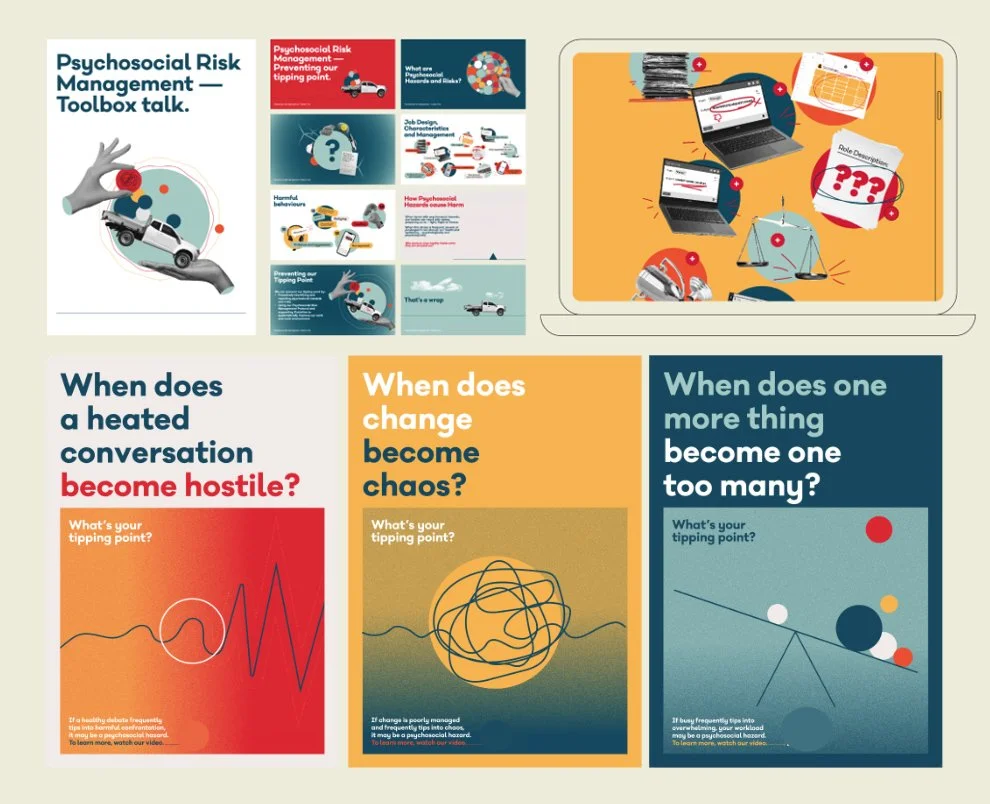HITTING THE BRIEF THIS SAFE WORK MONTH
The end of October sees the end of Safe Work Month in Australia, and this year’s theme has been powerful: Safety is Everyone's Business.
It’s a reminder that keeping our workplaces safe isn’t just about ticking boxes and relying on the safety team to carry the load—it’s about collective or shared responsibility, looking out for each other and doing whatever we can to put health, safety and wellbeing front and centre. With four themes in focus across the past month, we wanted to share some of our favourite collaborator work that hits the brief in each of these areas.
From the basics of work health and safety, to tackling psychosocial risks, mastering risk management, and addressing those all-too-common musculoskeletal injuries—we’re regularly partnering with organisations on end-to-end initiatives that level up their safety, engagement and leadership programs.
YES, SAFETY IS EVERYONE’S BUSINESS
For this year’s Safe Work Month, Safe Work Australia has put a powerful message front and centre: Safety is Everyone's Business.
It’s a reminder that keeping our workplaces safe isn’t just about ticking boxes and relying on the safety team to carry all the responsibility—it’s about collective or shared responsibility. With four themes across the past month, we wanted to share some of our favourite collaborator work that hits the brief in each of these areas.
Work health and safety fundamentals
The basics—always a good place to start. From proactively managing risks to consulting your people and then providing the learning and training that supports them to stay safe. This is where the EM team spends a lot of its time—in fact, learning and training as a service offering made up more than a third of our work in FY24. Our goal is always to meet workers where they are at, and from there we begin to shift behaviours.
One of the really great WHS fundamental training programs we recently developed was for Uber Australia and New Zealand. They wanted to onboard their two-wheel Earners (think bicycles and motorbikes) to safely prepare for their journeys, instilling positive safety habits from day one.
Psychosocial hazards
We only talked about tackling psychosocial hazards through leadership programs in the August edition of Everyday Insights, so we won’t spend too much time diving into this topic.
But we will say for one collaborator, we built both a frontline leadership program incorporating a module on psychosocial hazards, and a whole-of-organisation learning and communication program to support the roll out of the Psychosocial Risk Management Protocol. Through a suite of thought-provoking communication assets backed by comprehensive online learning and leader onboarding, we were able to introduce the idea of psychosocial hazards and how to manage them in this organisation. We know psychosocial hazards may interact and combine to create new, changed or higher risks, meaning an individual’s tipping point may differ from person to person. The Tipping Point became the lens through which we could strategically and creatively tackle this work.
Mastering risk management
Risk management is the bread and butter of any organisation’s approach to safety and wellbeing, but that doesn’t mean it has to be basic. By involving our people in risk management, we acknowledge that those closest to the work are often best positioned to identify hazards and suggest practical solutions and controls. Empowering them to take ownership fosters an environment where safety is an ongoing, evolving practice, rather than a top-down directive.
In fact, we’ve been developing a whole series of critical risk and critical control campaigns and learning experiences for some big organisations in 2024. From major retailers to infrastructure and construction companies, to local councils, this really has been the year of updating critical risk programs! Rather than show you just one approach, we’ve included a few snapshots from the work we’ve done on these programs recently.
Musculoskeletal injuries
We were pretty staggered to learn that musculoskeletal injuries (or MSIs) still make up around half of all serious workers’ compensation claims. This is despite all of our technological advances. Not a massive surprise to see healthcare and social assistance, construction and manufacturing are the industries with the greatest share of MSI claims.
We’ve definitely done some work with major aged care providers on MSI prevention, as well as leader-led safety engagement on body stressing for a national utilities company. But the one MSI related project the team had a lot of fun working on in recent times was for Garvan Medical Research Institute. Turns out the smartest minds in the country working to solve some of the biggest medical research challenges are as susceptible to MSIs as the rest of us!
Make incidents science fiction (since Garvan scientists work with science facts) was the umbrella idea to help shift behaviour on a range of their critical risks, manual handling included.
With fun assets like decals and stickers created that could be used at the point of risk (usually in labs) it was a light touch way to remind really smart workers of the essentials of preventing MSIs.
And that’s a wrap
As Safe Work Month wraps up for 2024, let’s remember: safety isn't a one-person job—it's a team effort. Whether you’re in the boardroom or on the frontline, everyone plays a part in creating a safer, healthier workplace. By keeping our foundations strong, tackling new challenges head-on, and staying switched on, we can make safety second nature. So, let’s keep that spirit of looking out for each other alive all year round, and keep building workplaces where everyone goes home safe and well.
And if you think the Everyday Massive team could help you build out safety, engagement or leadership programs in your organisation, feel free to book a call to discuss.








